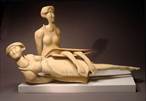 ALTERED PERSPECTIVES The sculpture of Jozef Sumichrast demonstrates the beauty of altered perspectives. Sumichrast has established his own unique language of compressed volume, an approach that transforms familiar subjects into extraordinary visions. The musculature of an animal, or even that of a human face, exists in the unexplored gap between two and three dimensions. His art operates not only on a sophisticated level of abstract spatial relationships, it also conveys a content distinguished by a respect for the natural world resulting from intense observation.
ALTERED PERSPECTIVES The sculpture of Jozef Sumichrast demonstrates the beauty of altered perspectives. Sumichrast has established his own unique language of compressed volume, an approach that transforms familiar subjects into extraordinary visions. The musculature of an animal, or even that of a human face, exists in the unexplored gap between two and three dimensions. His art operates not only on a sophisticated level of abstract spatial relationships, it also conveys a content distinguished by a respect for the natural world resulting from intense observation.
These unexpected effects are the result of the artist's chosen materials, particularly cardboard, onto which he transfers drawings made from the two-point perspective favored by architects. Spontaneous changes occur as the artist bends and curves the cardboard into the shapes that he envisions, before it is cast in bronze. The sculptures look almost squeezed, like rock under pressure. This forceful tactic gives the work a more vigorous, assertive density, as well as a harder, refined surface reminiscent of Brancusi. Indeed, when these polished, elegant surfaces draw light, art and nature engage in a perceptual dance. The narrow dimensions of people, animals or angels, which one normally expects to see portrayed with accentuated fullness, reflect the artist's own emotionalpressures experienced during the creative process.
Sumichrast's unique vision of animals reminds us of nature's mysterious magnificence. The body of the animal, in itself wild and untamed is first solidified in bronze so that the energy of the creature is contained within a man made context. Sumichrast shows us a wild cat in "Narrow Cat" (1993, bronze), a fierce feline that is curled like a letter "C", front paws are tucked in under its chest, back arched into a near-perfect curve. When viewed from the front, we see how truly remarkable the compression is, for all the muscles are heightened as curving planes of material mass, yet they are also skewed in contrast to conventional anatomy. The face appears squeezed in on itself, yet remains menacing, in what might be a metaphor of our own human anxieties.
There are also direct connections to religious statuary in Sumichrast's oeuvre. The title "Two Face Angel" (1992) responds in dialogue to Fernando Botero's genderless angel. Sumichrast plays on our human desire for some type of spirituality. As he observes, "There's a certain feeling of immortality with a piece of bronze, since it will be around for a long time." Sumichrast appreciates the indestructible nature of bronze, as well as the tactile quality of a three-dimensional work, including the way repeated touch forces the patina to be reduced over time in certain spots. the visual timelessness of style works with the capacities of nature itself to place the art in a state of constant evolution. The present finds Sumichrast moving into a deeper exploration of the human body's innately beautiful symmetry, with its numerous muscles and bones. He closely follows his instincts, as he continues forward on a different branch of artistic discovery divergent from that strategic point in art history when the Abstract Expressionists tried to make the human figure obsolete. The aritst's path rivals that of Chuck Close, an individual who creates his unique form of portrait work outside of an established group or trend. In his own way, Sumichrast uses his art to stimulate the imagination, at a time when many new artists are playing games with people's minds. As always, it is the material, with the artist's guiding intent, that pushes the art into new, unpredictable directions.
Jude Schwendenwein